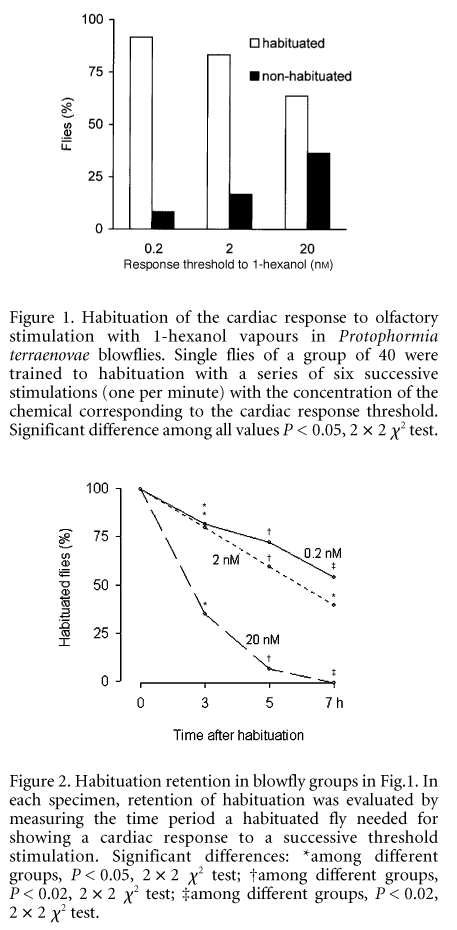Insect olfactory systems exhibit peculiar similarities with those of vertebrates, and offer unique advantages for studies on learning and memory formation and storage (Waddell & Quinn, 2001). Besides eliciting direct behavioural responses, olfactory input induces cardiac responses which sensitively indicate insect reactivity to odours (Angioy et al. 1998).
By using insect cardiac responsiveness in testing odour detection, we have designed an experimental protocol for an in vivo analysis of the temporal dynamics of olfactory learning and memory in flies.
Simultaneous electrophysiological recordings of cardiac activity by ECG and olfactory response from antennal sensilla stimulated with a concentration series of 1-hexanol vapours were performed on intact, restrained adult Protophormia terraenovae blowflies (Angioy et al. 1987; Angioy & Pietra, 1995). The cardiac response threshold in single specimens of a group of fifty was firstly measured as corresponding to the minimum odour concentration needed for inducing a cardiac response. Thereafter, a series of consecutive stimulations (one per minute) was performed on each fly by adopting the odour concentration corresponding to the cardiac response threshold value detected in that specimen. Effects of a series of three and of a series of six stimulations were tested on separate groups of specimens. One minute after a given stimulation series, a further single stimulation was performed in order to check whether the cardiac response had or had not vanished, i.e. whether or not habituation had taken place. Habituation persistence was evaluated by measuring the time period a fly needed for showing a cardiac response to a successive stimulation.
The highest percentage of habituated flies (92 %) showed the lowest response threshold (1st group: 0.2 nM) (Fig. 1). A slightly lower number of specimens (83 %) exhibited a higher response threshold (2nd group: 2 nM), while the lowest percentage of habituated flies (64 %) showed the highest threshold value (3rd group: 20 nM). In the latter, habituation acquired after a series of six stimulations was retained for the shortest time period, with 36 % of them showing 3 h memory (Fig. 2). More than 50 % of specimens of the 2nd and 3rd groups showed 5 h and 7 h memory, respectively. On the other hand, flies trained to habituation after a series of three stimulations showed a maximum of 3 h memory, even in the case of specimens with the lowest response threshold (0.2 nM of the chemical).
The results show the existence of an inverse relationship between cardiac response threshold to olfactory information and response habituation, i.e. the greater the olfactory sensitivity, the more learning is induced. Moreover, greater sensitivity was found to be decisive in determining the longest period of memory retention and consolidation.
This research work has been supported with funds from the Italian Ministry of Universities and Scientific Research (ex 40 %).

